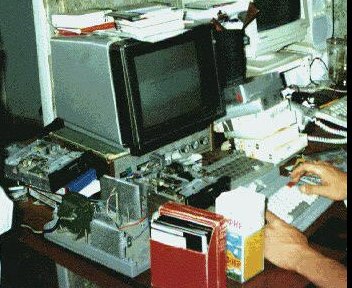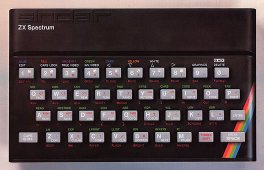Introduction
Back in the early eighties the 8-bit home computers were fighting a war.
Looking back it is still not clear who was the winner then.
Commodore and Amstrad might have ruled in Western Europe,
but the Soviet Union and a part of Eastern Europe belonged to the computer which this article is about.
We are talking about the Sinclair ZX-Spectrum, the ingenious invention of an englishman named Sir Clive Sinclair.
The Speccy (this is how every ZX-Spectrum fan calls his beloved computer) is still a very popular demoscene machine in these parts of the world.
In this article you can read about the possibilities and limitations of this machine.
Description
The first real Speccy model was released in 1982, called the ZX-Spectrum 48.
It was equipped with Zilog Z80 3.5MHz central processor and 48K of RAM.
There was no floppy drive or musical coprocessor - just a bunch of tapes one could load/save with his home tape-recorder and a beeper,
whose sounds were rather psychotic than melodic.
The next Speccy model, the ZX-Spectrum+ was released in 1984.
It differred from the previous one by an improved keyboard.
Two years passed, and the Speccy was desperately fighting for its warm place under the sun.
Absence of a proper sound chip or highly developed graphics system made this process more than just hard.
Fortunately for all the devoted fans it lasted only untill the very end of 1985,
when the new ZX-Spectrum 128 model appeared in the world of 8-bit computers.
This upgraded Spectrum had doubled its RAM size and added a sound chip AY-8912 with its 3 channels and wide stereo capabilities (just like inside the Amstrad CPC).
This made the ZX-Spectrum one of the most popular 8-bit home computers ever, especially in the (former) Soviet Union.
The two last models of the official Spectrum family were ZX-Spectrum 2+ (1986), equipped with internal tape-recorder and ZX-Spectrum 3+ (1987) which added an internal floppy drive.
|
|

|

|
ZX computers were very simple in design and this made them easy machines to clone.
Within only a few years of the initial launch, a huge number of illegal clones had been produced around the world.
More clones were produced in the Soviet Union than in the rest of the world combined.
This started at a time when the average monthly income was just 250 roubles a month, and an original Spectrum cost 40000 roubles - equivalent to 13 years' wages.
The most popular model of the new generation of Russian ZX-Spectrum clones was the Pentagon 128 (photo on the right).
This machine was followed in the nineties by the Scorpion 256 and Kay 1024.
These later models provided users with extra memory and higher processor speeds,
but the Pentagon 128 keeps holding its status of the most popular ZX-Spectrum clone in Russia.
Basically, Pentagon 128 is a completely hand-made computer, and it can transform to any form.
So you shouldn't be surprised when you find Pentagons in PC tower cases, with a PC keyboard and SVGA monitor.
As you can see on the image on the right side of this page,
a Pentagon is sometimes no more than a bunch of circuit boards and wires laying on a table!
|
|

|
Graphics
Even though there have been a lot of Spectrum machines developed,
the graphical capabilities have not evolved as much as you might have expected.
Every ZX-Spectrum has a palette of 8 colours and all of them can simultaneously be displayed on the screen.
The palette is fixed, and the colours at your disposal are: black, blue, red, magenta, green, cyan, yellow and white.
You can also use the brighter version of each colour by switching on the 'brightness' option while drawing.
So, in practice, you can use 15 different colours on the same screen ('black' has no bright equivalent).
There is a unique limitation on the graphical capabilities of the Speccy, which gives the graphics from this platform very distinctive characteristics.
The screen is divided in so-called 'symbol-places', which are pixel blocks of 8*8 pixels.
Each of these blocks can contain at most 2 different colours and these colours have to be of the same brightness level!
The image below shows a graphical example of this principle.
|
|

